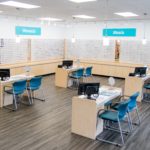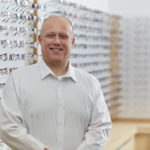By Kirk Lauterback
COO, Shopko Optical
June 10, 2020
It’s no secret that our lives have changed radically in the wake of COVID-19. Masks and social distancing have become the norm as we try to prevent exposure to the virus, but which new protocols are going to stick? And what does the virus mean for optometry?
As the chief operations officer for Shopko Optical, I lead the team that’s rolling out safety initiatives and plans for reopening our centers. Here are some insights I’ve learned in the process, along with steps you can take as you plan for reopening and practicing optometry following the pandemic.
Understanding and Implementing the Guidelines
With varying guidelines on safety protocols for businesses, every industry is trying to tackle which safety protocols to follow and what those look like in their establishment. While a lot remains uncertain, our industry has done a good job of coming together to find the best path forward.
In addition to Centers for Disease Control, federal and regional guidelines, the American Optometric Association, The Vision Council and state optometric associations have all compiled resources and established recommended best practices for patient and employee safety. These include providing personal protective equipment (PPE) to both patients and staff, implementing additional disinfecting and sanitizing procedures, and conducting surveys on patient and staff exposure to COVID-19, as well as other measures.
Other Articles to Explore
As part of Shopko Optical’s reopening, we took all of the above guidelines into consideration to develop a strategic plan, which was distributed to all of our team members and reviewed in teleconferences. We also coordinated follow-up calls and in-store visits from regional managers and established an online resource for employees to reference or ask questions. Further, we monitored the latest data from the regions where our centers are located to determine which centers are at the highest risk and phased our re-openings accordingly.
Securing PPE
Although it’s hard to make predictions about how practices will change in the long term, we can expect that using PPE will become the standard across the industry. In our centers, we’ve installed plexiglass sneeze guards and have masks, face shields and gloves available. Patients will be required to wear face masks, which we provide if they don’t have their own. We’re also providing hand sanitizer throughout our centers and encouraging frequent hand-washing.
New Safety Protocols
Beyond ensuring PPE is available to guests and opticians, we’re adding new safety protocols and social distancing guidelines and continuing the frequency of rigorous cleaning across highly trafficked areas.
At the start of the appointment, in addition to a routine intake, we’re now taking patients’ temperatures using a touch-less thermometer. Patients with a fever of 100.4 or greater will be asked to reschedule their appointment. Staff will also have their temperatures taken upon arriving for their shift and halfway through the day. Before seeing their doctor, patients complete a questionnaire to determine whether they may have been exposed to COVID-19, which helps mitigate the risk of spreading the virus to other patients or our staff.
Our centers are also practicing social distancing by reducing the amount of staff and patients in the center at a time. All visits to our centers require an appointment. We’ve asked patients to arrive by themselves unless they require a parent or guardian. To help encourage social distancing, we offer curbside pickup and free shipping and delivery of eyewear. If patients browse and select eyewear in-store, we sanitize the frames after a guest tries them on, and we’re continuing to disinfect our optical equipment and instrumentation following the exam.
Prioritizing Safety and the Patient Experience
Although we’ve increased our safety and cleaning measures, we’re looking to keep the patient journey similar to what we had before. Changes to the patient journey should be as seamless as possible, especially as we prepare for potential resurgences of the virus. The key to making the process easier for patients is being open about new practices and guidelines, being available to answer questions and providing PPE to those patients who don’t have it. Communicate that you’re working on minimizing risk for both your patients and your staff.
Fortunately, in my experience, patients and employees have been receptive to and appreciative of our new safety initiatives. Adding new safety protocols and communicating those efforts shows patients that you value their eye health and overall health as well.
The Role of Online Optical Solutions
Telemedicine has been available for several years, but the pandemic has accelerated the number of eyecare practices offering it as well as innovations to its software. Telemedicine, as we define it, involves using high-definition teleconferencing, remote operated equipment and software to provide a comprehensive eye examination remotely. Especially during these times, telemedicine is a functional solution, as it can provide additional access to diagnosis of (and follow-up on) certain ocular conditions as well as added patient convenience.
Telemedicine examinations have come a long way when it comes to diagnosing specific eye conditions. The ideal patient experience for Shopko Optical is still an in-person visit with an optometrist, but with structured approaches to reopening and fewer staff members in centers at one time, it is now a viable option for routine eye exams in select centers. When patients come into the center for their telemedicine appointments, they are able to have an exam with a remote optometrist at a time that is convenient for them.
When it comes to online solutions, such as purchasing eyeglasses online, one of the main limitations is with fitting and adjustment. While some patients may find it more convenient to order glasses online, there are obstacles with this process. Not only is there no final fitting, it’s harder for the optician to know whether the patients are wearing the glasses correctly, such as in the case of progressive lenses. In those instances, it’s essential to prioritize the in-person experience.
Working Together
It’s been comforting to see the efforts from our industry in combating this virus. I’m proud to be part of such a collaborative industry that puts health and safety at the forefront of its discussions.
 Kirk Lauterback is chief operating officer of Shopko Optical. To contact him: Kirk.Lauterback@shopko.com
Kirk Lauterback is chief operating officer of Shopko Optical. To contact him: Kirk.Lauterback@shopko.com





















